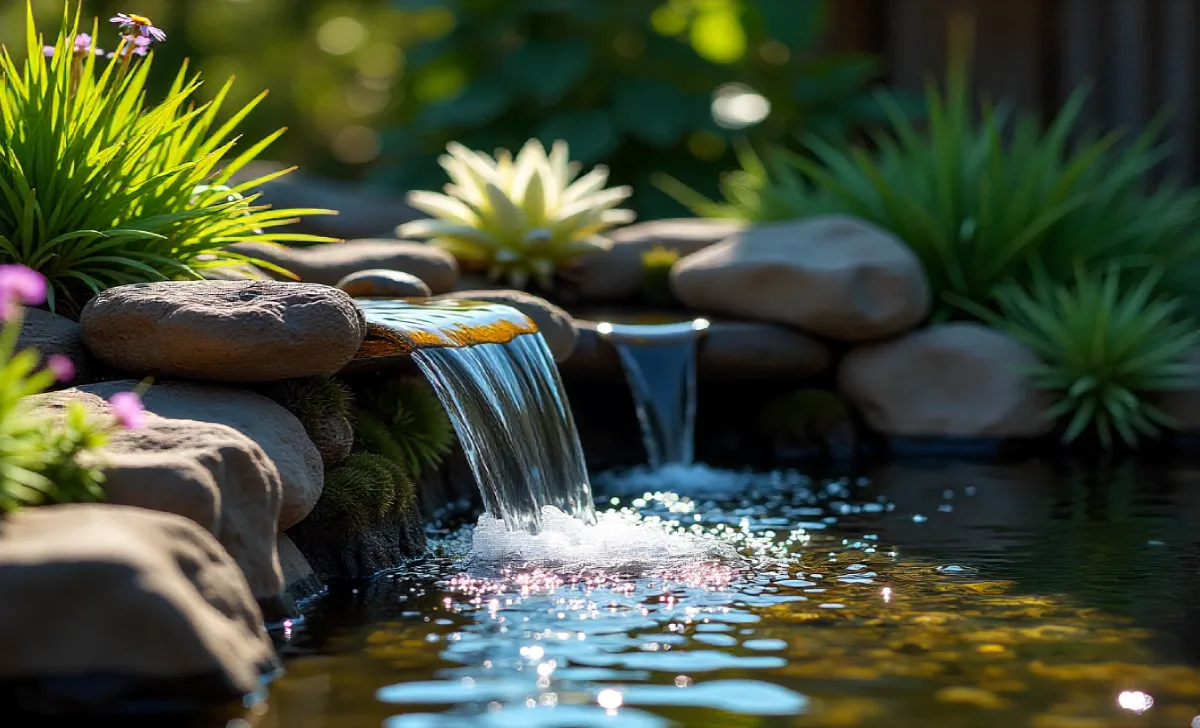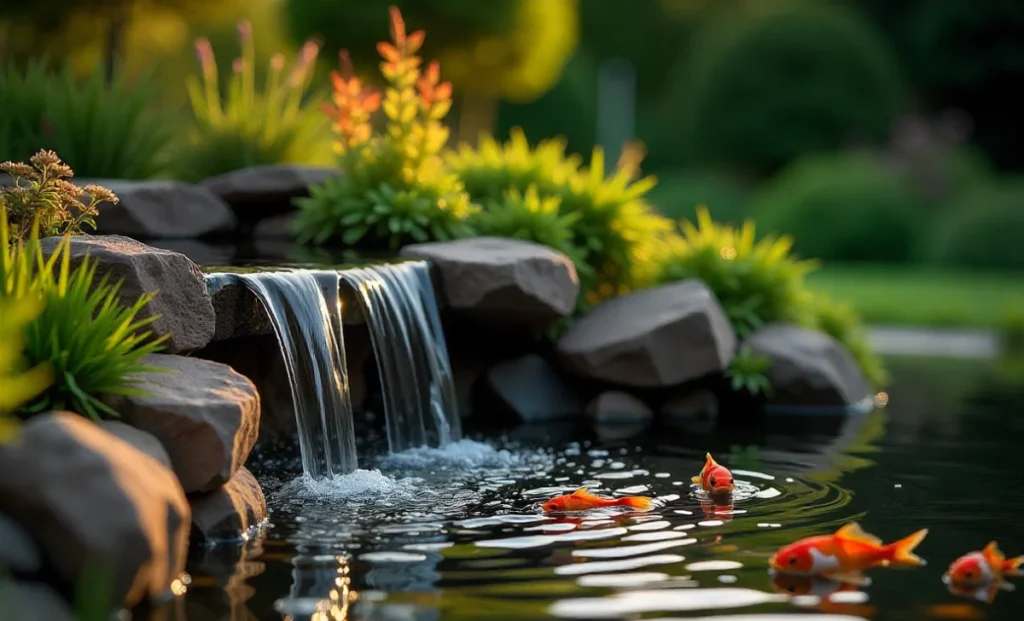A Pond with Waterfall combines a recirculating water feature with a natural-looking cascade system. Installation requires proper excavation, a waterproof liner, a filtration pump, and strategic rock placement. Most backyard installations cost $1,500-$8,000 and take 2-5 days to complete with basic tools.
Does your backyard feel lifeless? You’re not alone. According to the National Association of Landscape Professionals, 73% of homeowners want water features but don’t know where to start.
A Pond with Waterfall transforms any outdoor space into a peaceful retreat. You’ll learn exactly how to plan, build, and maintain your own water feature, plus discover design ideas that work with any budget or skill level.
Planning Your Pond with Waterfall
Location determines everything. Choose a spot visible from your home’s main living areas. Avoid areas under large trees where falling leaves create maintenance headaches.
Size matters more than you think. A 6×8 foot pond works well for most yards, while waterfalls need at least 18-24 inches of elevation change to create proper flow. Mark your planned area with spray paint before digging.
Check local building codes first. Many municipalities require permits for water features deeper than 18 inches or larger than 200 square feet.
Essential Materials and Tools
Your shopping list should include these core items:
• Flexible pond liner (45-mil EPDM rubber recommended) • Submersible pump (calculate 100 gallons per hour for each inch of waterfall width) • Skimmer box and biological filter • Underlayment fabric • Various-sized rocks and gravel • Pond-safe foam sealant
Tools you’ll need: spade, level, wheelbarrow, garden hose, and basic measuring tools.
Budget between $1,500 for a simple 6×6 foot setup and $8,000 for elaborate designs with multiple cascades. “Most DIY pond installations fall in the $2,500-$4,000 range when done properly,” says Mike Henderson, certified aquascape contractor with 15 years of experience.
Excavation and Foundation Work
Start digging your pond area first. Create multiple depth levels: shallow shelves at 6-12 inches for plants, and a deep zone of 18-24 inches minimum for fish survival during winter.
Shape matters for circulation. Kidney or figure-eight designs move water better than perfect circles. Avoid sharp corners where debris collects.
For the waterfall area, excavate upward from your pond edge. Create a gentle slope rather than steep drops. Pack soil firmly to prevent settling that causes liner tears.
Test your excavation with a garden hose filled with water. This reveals low spots and drainage issues before you install the liner.
Waterfall Construction Techniques

Build your waterfall structure with rocks, not concrete. Natural stone looks better and allows for easy adjustments. Start with larger foundation rocks and work upward with smaller stones.
Create spillways using flat rocks that extend slightly over the edge. Water should fall cleanly into the pond below, not trickle down the rock face.
Position your pump intake at the pond’s deepest point, opposite to where water returns. This creates proper circulation and prevents dead zones where algae grows.
“The biggest mistake I see is inadequate pump sizing,” notes Sarah Chen, water garden designer and author of “Backyard Water Features Made Simple.” “Calculate pump requirements based on both waterfall width and total system volume.”
Filtration and Water Quality
Biological filtration keeps your pond healthy. Install both mechanical skimming and biological filter media. A properly sized system processes your entire pond volume every 2-3 hours.
Beneficial bacteria colonize filter media and break down fish waste plus organic debris. Add bacterial supplements during startup and after cleaning.
UV clarifiers eliminate green water algae but won’t solve underlying nutrient problems. Address excess nutrients through proper filtration and regular maintenance instead of relying solely on UV treatment.
Plant Selection and Placement
Aquatic plants do more than look pretty. They absorb nutrients that would otherwise feed algae growth. Aim for 50-60% plant coverage across your pond surface.
Choose plants for different zones:
• Marginal plants (cattails, arrowhead) for shallow edges • Floating plants (water lilies, lotus) for deep areas • Submerged oxygenators (hornwort, cabomba) for water clarity
Plant in early spring after water temperatures reach 60°F consistently. Use aquatic plant fertilizer tablets, not garden fertilizer that promotes algae blooms.
Fish Selection and Care
Goldfish and koi are popular choices, but they have different requirements. Goldfish thrive in smaller ponds and tolerate temperature fluctuations better. Koi need larger volumes (minimum 1,000 gallons) and more advanced filtration.
Stock conservatively: one inch of fish per 10 gallons of water initially. Fish grow and reproduce, so overcrowding happens quickly without planning.
Feed fish only what they consume in 5 minutes during warmer months. Stop feeding entirely when water temperatures drop below 50°F, as their metabolism slows dramatically.
Seasonal Maintenance Tasks
Spring brings startup activities. Remove debris, restart pumps, and add beneficial bacteria to reestablish biological filtration. Test water chemistry and adjust as needed.
Summer requires weekly water level checks and monthly filter cleaning. Hot weather increases evaporation and concentrates nutrients that fuel algae growth.
Fall means leaf management becomes critical. Install pond nets or skim daily to prevent organic buildup that creates toxic gases under winter ice.
Winter care varies by climate. In freezing regions, install pond heaters to maintain gas exchange holes. Stop feeding fish and reduce pump flow to prevent ice damage.
Troubleshooting Common Issues
Green water usually indicates nutrient imbalance, not equipment failure. Reduce fish feeding, increase biological filtration, and add more aquatic plants before considering chemical treatments.
Waterfall flow problems often stem from clogged pump intakes or inadequate spillway design. Clean pump screens monthly and adjust rock positioning for proper water flow patterns.
Liner leaks show up as unusual water loss beyond normal evaporation (about 1 inch per week in summer). Look for wet soil around pond edges and repair with pond-safe patches.
Budget-Friendly Design Ideas
Create impressive waterfalls without breaking your budget. Use locally sourced fieldstone instead of expensive imported rocks. Many quarries sell “seconds” at reduced prices.
Repurpose materials creatively. Old concrete blocks make solid foundation supports when hidden under decorative stone. Plastic storage containers become biofilter chambers with proper modification.
Start small and expand later. Build your basic pond first, then add waterfall features as budget allows. This spreads costs over time while letting you learn system requirements.
Professional vs DIY Installation
DIY installation saves $2,000-$5,000 in labor costs for average projects. You’ll need 2-5 days, depending on size and complexity, plus physical capability for moving rocks and digging.
Consider professional help for complex designs, electrical work, or if local codes require licensed contractors. Get multiple quotes and check references before hiring.
Hybrid approaches work well: hire professionals for excavation and electrical, then handle liner installation and decorative work yourself.
FAQs
How deep should my pond be?
Minimum 18 inches for fish survival, with deeper zones of 24-36 inches in harsh winter climates. Include shallow 6-12 inch shelves for plants and easy maintenance access.
What size pump do I need for my waterfall?
Calculate 100 gallons per hour for each inch of waterfall width, plus additional capacity for head height. A 12-inch wide waterfall needs at least a 1,200 GPH pump rating.
Can I build a pond waterfall without fish?
Yes, fishless ponds require less filtration and maintenance. You can focus purely on aesthetic design without biological load concerns from fish waste.
How much does it cost to run a pond waterfall?
Energy-efficient pumps cost $15-$40 monthly to operate, depending on size and local electricity rates. LED lighting adds $5-$15 per month for evening enjoyment.
When is the best time to install a pond?
Spring through early fall offers ideal working conditions. Avoid winter installation in freezing climates, but mild winter areas work fine for construction timing.


